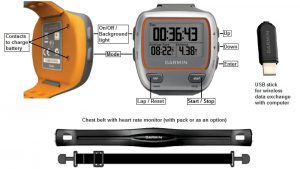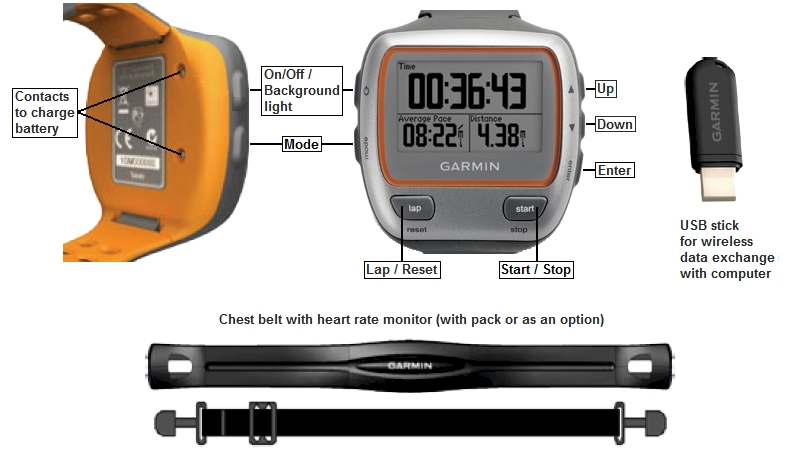 Heart Rate Training Devices
Heart Rate Training Devices
I Had an good question from one of our RunRunLive tribe, Lisa this week about HR training devices.
To paraphrase, she wants to try HR training but is overwhelmed by the variety of choices in monitors themselves. She thinks she wanst a wrist device with a large, easy to read continuous display. Perhaps one that would signal when I went above the heart rate limit I set, too. Can you recommend one that you think would fit this description, or that you may use yourself?
First, a great resource for this stuff is Ray Maker (DCRainMaker) https://www.dcrainmaker.com/ – We talked to Ray not that long ago in episode 4331. He goes deep and he maintains a recommended device list for all sport combinations and men and women.
The main question here is of the hundreds of devices what is best for HR training? It’s tough because all the different technologies are leaping ahead quickly. As a starting point any HR device needs to measure the HR.
How do they do this? Theoretically you could measure your heartrate by placing a sensor anywhere on your body. I’ve seen simple, finger based sensors, like the Polar monitor clips on the treadmills in the gym. When you get a stress test from the cardiology lab they are going to stick, or a cardiogram they are going to stick sensors all over your body. They are measuring not only your heart rate but how well it transmits to different parts of your body.
For the recreation use out in the wild we still basically have two choices for HR monitoring. The wrist based systems and the HR strap. Note, there are sports headphones now that have HR sensors in them, but I haven’t done any experimenting with them. If someone at Jabra wants to send me a pair, I’ll test them out. I suppose you could design a device for nestling in any available body crevice. Maybe there’s a business for HR nose rings or something – I freely gift that business idea to you. Get in on the ground floor.
Let’s not go down that rat-hole. The possibilities are disturbing.
Writs based HR monitoring is the maturing option. There is an emerging family of wrist-based HR tracking devices that don’t use a chest strap (think FitBit). They use optical sensors on the wrist to get your heart rate. In my experience (and Ray’s) these aren’t quite there yet. In my experience the HR report from the FitBit is directional at best but not super useful for training purposes.
These wrist based applications also typically have a phone app of some sort they utilize or report to via BlueTooth or some other protocol. This means if you want to get the real-time application of the device you need to have the phone with you. Which may or may not be a non-starter.
That leads us to HR straps.
What is an HR strap? Well it is just what it sounds like. It’s a stretchy strap with a HR sensor on it that you wrap around your chest. Not to get too personal but this is an area where men and women have different architectural challenges. The strap is typically about ¾ of an inch wide. It’s got the stretchy part on the back and the sensors on the front. The sensors are designed to nestle just under your pectoral muscles, on the front, right over where your heart should be.
Some people have a lot of trouble wearing the strap because of their particular physiques. My experience is that you get used to it fairly quickly. It will chafe if you have a lot of extra skin in that area and my understanding is this chafing is a particular issue from women. There are different styles of straps, and different generations of straps. Take the time to read the user reviews to see which one would work best for you.
The issues I’ve had with the straps are chafing and fidelity. I’m used to running with the strap and only worry about chaffing if I’m going to be out over 2 hours or racing hard. All I do is put a little lube on the edges of the strap, the same way I will lube my pointy bits or my the waist line of my shorts. Worst case you get a nice little razor cut from the edge of the strap.
The other issue I get, especially in the cold weather, is contact or fidelity. When it’s cold and dry the sensors don’t pick up well until you warm up. When the sensors don’t pick up the algorithms try to guess and you get screwy readings. A quick way to remedy this problem is to run your strap under warm water at the faucet before you put it one. Cold water works well but that is a bit shocking.
There is special gel you can buy for this exact purpose, but I wouldn’t waste your money, unless you’re a triathlete, in that case buy two jars because triathletes buy every useless, expensive thing, right? If you’re going to use lube make sure it’s not a petro-chemical based lube like Vaseline, because it can dissolve the plastic of the strap.
I should add here that putting on a strap that is still wet from the last time you wore it is a bit unsettling. You want to have a place to hang it up to dry after your run. One of the biggest issues with this stuff is locating it when you need it. You want to create a routine of always having it in one place and putting it back so you’ll have it when it’s time to run.
The good thing about the strap system is it is highly, highly, highly accurate in measuring HR. You won’t have to wait for a readout on your phone. It talks to your watch, typically via the ANT protocol, instantaneously. It works great for spot on HR training where a couple beats per minute is actually quite important.
Now, to narrow down the choices. You should decide what your use case is (are). Are you just looking to use the device for HR training? Do you also want pace, distance ect? How accurate do you need it to be? Are you going to do multi-sport? Do you need it to do biking? Do you need it to handle swimming? Are you going to want to use it for something Map-based, like Geocaching? Because each of these answers will narrow your possibility.
I’m going to assume we’re talking about running here. A few words on multi-sport. The running watches will typically do multisport as well in some form or fashion.
There’s really not that big a leap from tracking a run vs a bike. The extra functionality specifically for cyclists is the ability to interface with a power meter, a device built into the peddles that measures how hard you’re pushing. I’ve never had a power meter, don’t know much about it.
For swimming running watches tend to fall down a bit. First, can the watch go under water? Because that’s a bit of a requirement if you take it swimming. As most of us know there is a big difference between ‘water resistant’ and ‘water proof’.
The other big issue is that even if your watch goes under water the ANT communication protocol and most of the GPS signal, does not. This means even if you’ve got your HR strap on your watch won’t ‘hear’ it. It just doesn’t work.
It also means the watch only sees the satellites when your arm is above water and that gives you crappy GPS tracking even if you’re in an open water situation. What I do is tuck the watch under my swim cap and that allows it to stay in contact with the satellites when I open water swim.
If you’re doing geocaching or some other map-based navigation thing, that’s really another application altogether and you’re going to want a device specific for that. The navigation on your running watch is very basic. Although I did find my way out of the woods in the dark once using the watch after losing the trail.
Now – the good stuff. Running. Heart rate training.
You can still get HR specific devices – so the wrist device and the strap from Polar or other providers if that’s all you want. Then there are the endurance athlete specific watches. I’ve always run with Garmin. Although I do have a Suunto device that showed up at my house for no reason. I gave it to Teresa.
I started with the Garmin 205 which was just pace and distance – quite handy when I was traveling. When it’s battery died I upgraded to the 305 and added the HR strap when I started training with Jeff at PRSFit. These are the Buick Century of running watches. Bulky, big buttons, and bulletproof.
Currently I run with a Garmin 410XT and a HR strap. I’ve had it for a couple years. It’s bulletproof and fits what I need. Good GPS, HR for Running and Biking. Waterproof for swimming. Rugged. Good display. Great battery life – like 12 hours. Great at HR tracking, training and racing. The Ant interface works all the time with several different computers.
I don’t care too much about the ‘community’ aspect of these things. Garmin Express works without too much fuss and Garmin Connect does what I need it to do. It’s fun to look at the maps of your routes after you upload them and see your splits from races. It’s also informative to see how your HR responds in workouts to surges and climbs, etc.
The other thing that Lisa asks about is ‘continuously’ monitoring.
My experience is that you really can’t dial in either pace or HR instantaneously, especially when you’re learning. What this means is the expectation that you can have the watch buzz every time you’re off pace or your HR drifts is just going to, in my experience, drive you crazy.
I do use the workout feature to remind me when I’m supposed to do something. Like during a step-up run where I want it to buzz minutes in when the step up starts. I also use have it set to buzz automatically every mile so I can get a quick pace and distance update. Remember, when I’m HR training I don’t look at pace or distance.
I’ve gone too long on this post already. Let me summarize by saying the most important thing is not the device. It is the understanding of your HR zones. If you’re going to do HR training you need to dial in your effort zones. That takes an HR coach’s help (Jeff PRSFit helped me initially set mine up) because the tables are too average for most runners.

